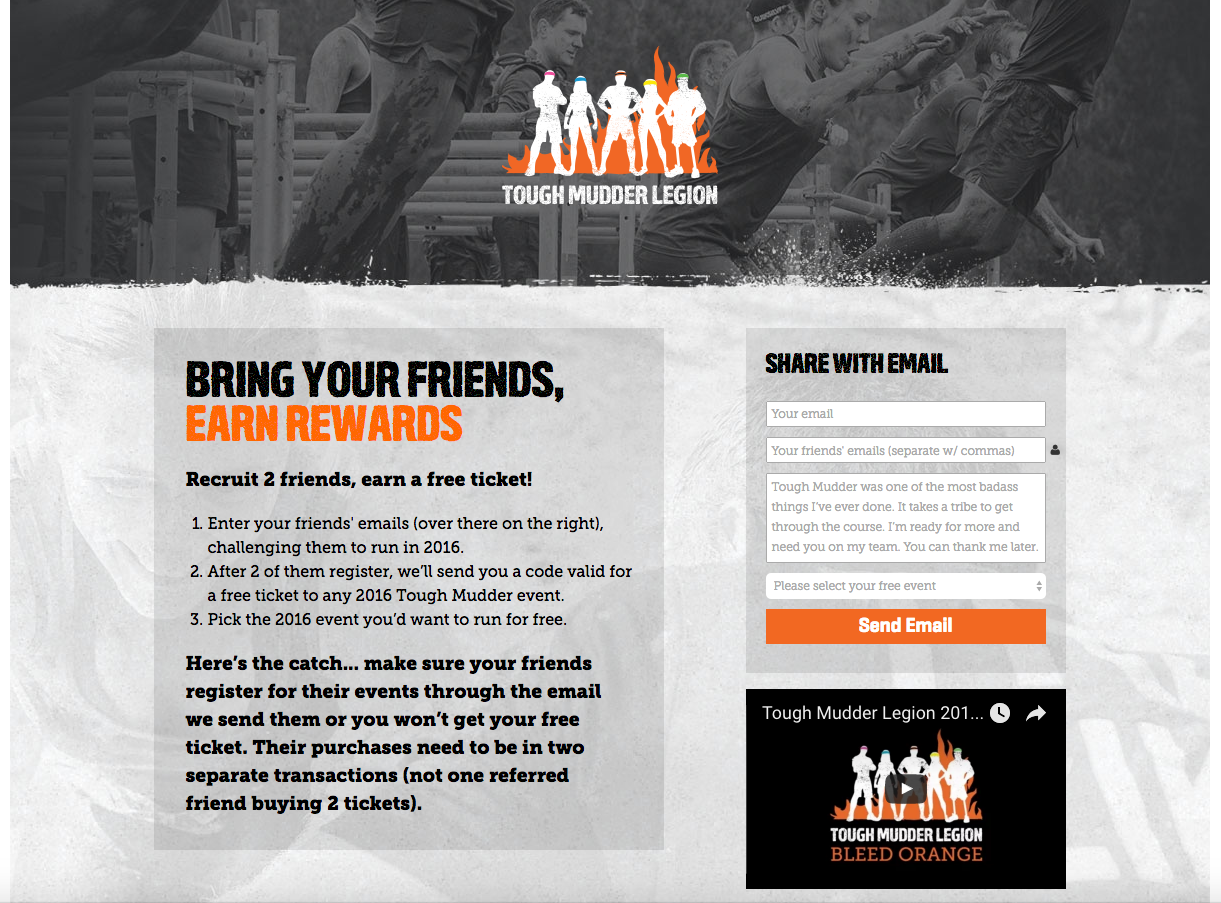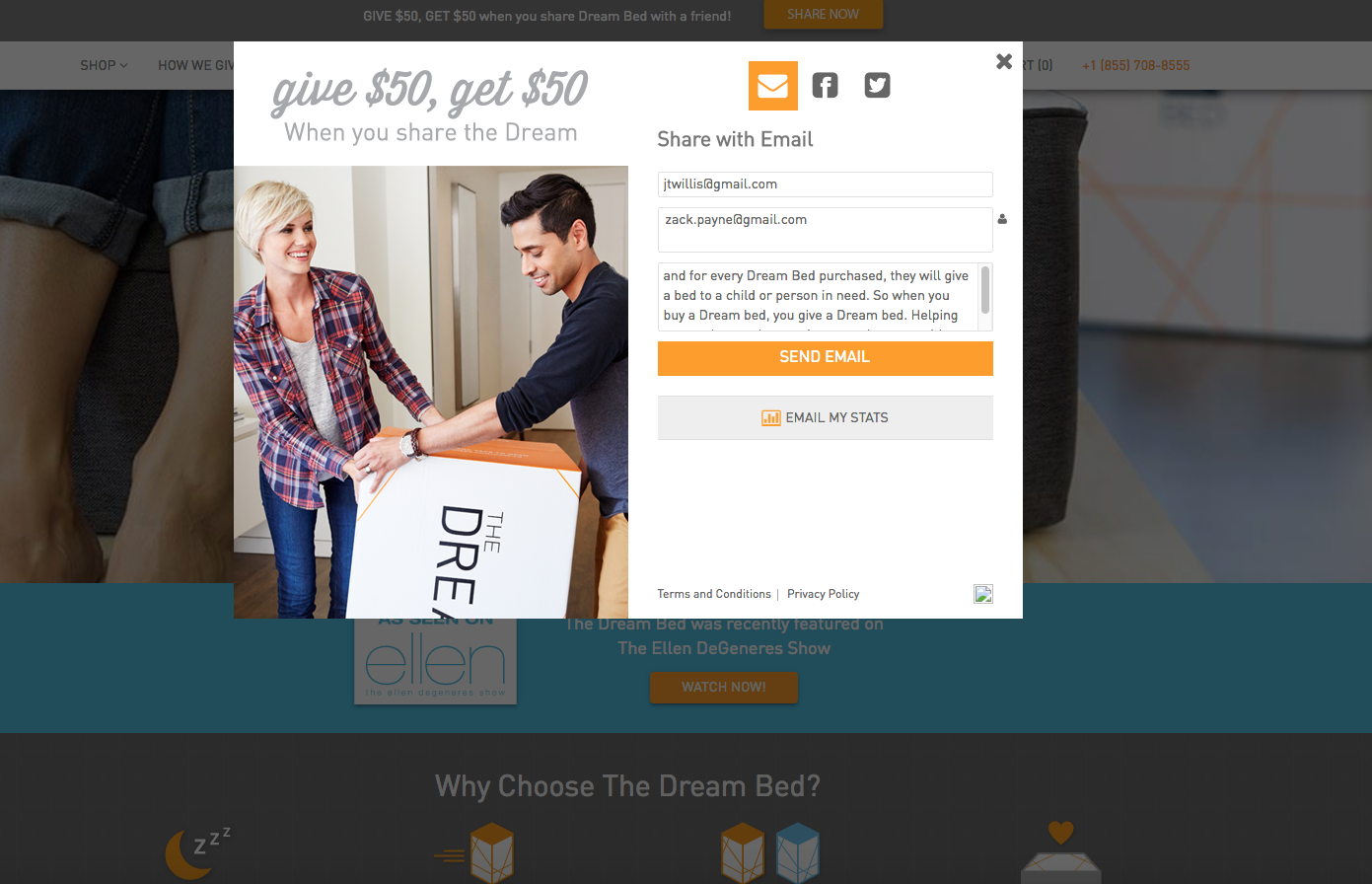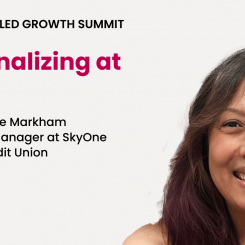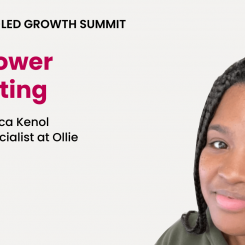Your brand is the promise you make to customers beyond a great product. Case in point: When Nike sold $2.6 Billion worth of Air Jordans in 2014, it wasn’t just because people wanted cool kicks. They knew they were buying an image that’s synonymous with hard work, swagger, and peak performance.
Referral, on the other hand, is often considered an impersonal transaction. Lots of marketers just think, “I’ll give my customers $5 in store credit and they’ll refer all their friends.”
That couldn’t be more wrong. Referral is the most personal kind of marketing because it taps into the word of mouth recommendations people make to each other every day. But no matter how much of a reward you offer, your referral program needs to deliver on the promise your brand makes if you want customers to share referrals for your company. Here are three ways companies have used referral to advance their unique brands.
Dream Bed’s Referral Program Boosts its Social Mission
Worldwide, 55% of consumers now say that they’re willing to pay more for products from companies committed to social and environmental causes. And few companies blend charity and business quite like mattress provider Dream Bed. For each mattress customers purchase, the company donates one to somebody in need.
Social responsibility is Dream Bed’s brand, and it also fits their refer-a-friend program perfectly. The reward structure is simple at first glance: Advocates and new customers each get $50 in store credit. But Dream Bed frames the ability to “buy a Dream Bed, give a Dream Bed” as a reward in its own right for the advocate’s friend. That reinforces the brand’s philanthropic image, and positions sharing a Dream Bed referral as much more than helping a friend get a comfy mattress—it enables them to do something positive.
How to Put a Charitable Spin on Referral
Unlike Dream Bed, your entire business probably isn’t built around charity. But that doesn’t mean you can’t turn your referral program into a chance for your customers to do some good. Here are three ideas.
- Give away the reward. Most referral programs offer a reward either to the advocate, the new customer, or both. You could instead make that reward a donation in either party’s name, and turn referral into an act of charity.
- Recognize your superadvocates. Every company should thank the people who advocate the most (https://www.extole.com/blog/5-psychology-principles-of-refer-a-friend/), and if your referral program is tied to charity, you have a special way to do that. Let’s say your referral program donates to fight malaria—you could give superadvocates a badge for their social media profiles that says something like, “I’ve paid for X mosquito nets.”
- Show off the results. After holding a referral campaign tied to charity, don’t leave participants hanging—show them all the good they did. Create a blog post or a video highlighting those who benefitted from your referral-realated charity, and build excitement for future efforts.
Each of those ideas shows customers that your company cares about more than its bottom-line, and gives referral participants the chance to give back.
Tough Mudder Lets Competitors Refer their Next Teammate
Consumers are increasingly deciding they have enough stuff, and opting to spend their money on affordable but memorable social events instead. From 2011 to 2013, ticket sales for events like concerts, festivals, and themed races more than tripled.
Tough Mudder has tapped into that trend and grown into a $100 Million company putting on team-based obstacle course races around the world. Its referral program especially takes advantage of its brand’s social power. Advocates are invited to “recruit two friends” and get a free race once they sign up. So as an advocate, you don’t just get to race for free—you also now have two buddies to team up with.
What’s genius is that, even ignoring the tangible reward (the free race), sharing referrals automatically enhances an event like Tough Mudder because it’s designed to be better with friends—the more people someone refers, the more people they can compete with. The new customers are a win for the advocate, and not just for Tough Mudder.
How to Make Referral More Social
Even if you’re not putting on group-geared events, you can still entice customers to refer by highlighting the communal aspects of your product. Consider these three ideas.
- Make the referral message personal. Have the referral come from the advocate’s personal email address, and work in their name and picture as much as possible. The new customer should be thinking, “Here’s the person I could be enjoying this product with by accepting this referral.”
- Optimize for cross-device referral. Our data shows that while just 18% of referrals are sent from a mobile device, 39% are accepted on one. Friends want to refer each other whenever the mood strikes—they could be emailing, texting, or having lunch together, so you need to make sharing and accepting referrals seamless on any device.
- Reward togetherness. Give extra rewards to customers who use your product together. For example, if you ran an e-commerce fashion store, you could hold a contest on Instagram for “best group photo of people wearing our clothes,” and give the winners store credit.
Referral is an inherently social activity, and you can generate more excitement if you structure your program accordingly.
Tesla Thinks Big, and so Does its Referral Program
Tesla has become one of the most hyped companies in the world, and it’s not just because of its cars—it’s because of branding too. Its mission is clear: make electric cars mainstream. And founder Elon Musk’s involvement with PayPal and SpaceX gives him a personal brand somewhere between Henry Ford and Steve Jobs. So, buying a Tesla isn’t just about getting a slick car that saves money on gas. It’s about being one of the first people to adopt the eco-friendly future of auto.
Tesla’s referral program delivers on that branding by partnering with SpaceX. Any customer who shares a successful referral is entered into a sweepstakes. Five runner-ups get a tour of SpaceX’s headquarters, while the first prize winner gets the tour, plus a brand new Tesla car.
The message is clear: Share Tesla, and you might get to see something out of a science fiction movie. Sure, most people don’t really expect to win. But the mere fact that Tesla can even offer such a once-in-a-lifetime opportunity—a legitimate look into the future—is just as compelling as a more tangible reward to Tesla customers.
How to Make Referral as Big as Your Mission
Here are some ways your referral program can stay consistent with your company’s mission and values.
- Highlight community. Tesla positions its customer base as a distinct community dedicated to the company’s mission, and that’s how it frames the act of referral: building up that community. This emphasizes that their customers are projecting a set of values, and not just getting a great product.
- Contests make a splash. You may not have a space launch facility, but a sweepstakes for advocates lets you offer a massive prize that builds a ton of buzz while still remaining cost-effective since you’re only giving it to a few winners.
- Balance it out with a conventional reward. Tesla also offered newly-referred customers $1,200 off on their home charging station installation. That let them balance the long odds of the SpaceX sweepstakes with a guaranteed reward for every referral on the new customers’ side.
Each of these ideas gives your referral program practical ways to live up to your brand’s lofty values.
The Best Brands Keep Their Promises
Tesla, Dream Bed, and Tough Mudder couldn’t be more different when it comes to brand positioning, but all of them use referral marketing to reinforce the image they’ve chosen.
Here’s the thing: Referral marketing isn’t just some kind of bribe to get current customers pumping in new ones. The best referral programs tap into the power of word of mouth and make advocates feel genuinely excited to share a product with their friends.
The best way to do that is to make sure your referral campaign stays in line with the identity your customers have connected with. Provide rewards that align with who you are, deliver the magic your customers expect from you, and make referral a massive win for your brand.






